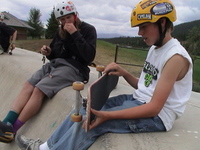
Browsing the content from our coaches manual below, you’ll see that it’s easy to make the mistake of buying a “toy” skateboard at a big box store or sporting goods store. A new skater, especially those who are smaller in size, perhaps ages 4 through 8, can benefit from having a “real” skateboard, and one that’s sized-down. At a skateshop, you can find a “mini,” or a smaller skateboard for kids.
The biggest problem with the imitation skateboards you can find at non-skateshops, is that the trucks don’t turn as well as real skateboard trucks, and the bearings don’t spin as well. These two factors hinder the new skateboarder’s learning almost immediately, making it harder for them to learn how to turn the board. Kids on these “toys” will also form the bad habit of bracing against wheel that don’t roll freely, hindering their learning later, and promoting falls that could have been prevented had they been on a real skateboard from the beginning.
Equipment Check: here’s an excerpt from our Concrete Fundamentals Coaches Manual,for your reference. The Manual is available at this time, for free, with purchase of the Document Pack.

All skaters should use a proper skateboard from a skate shop or online retailer that sells real skateboards. Unfortunately, there are some toy companies producing “skateboards” that sell at big box stores and sporting goods stores, which do not turn properly, have plastic wheels instead of urethane, and sticky bearings. These toys can lead to learning difficulties. While they are used as an economical way to introduce skateboarding to younger kids, once they begin to learn their balance on the board, the plastic trucks and cheap bearings will hinder their learning, and the plastic wheels can slip unexpectedly. Skaters learning the fundamentals in this manual need to be riding a real skateboard, with real trucks, urethane wheels and proper bearings. A “complete,” or a full skateboard from a skate shop can last years with very little maintenance, as only the deck needs to be replaced periodically. Smaller kids from about 10 years old and younger should get a “mini,” or sized-down skateboard. Mini’s are real skateboards, just smaller.
As for Skateboard Decks, if you are setting up a skateboard from purchased parts, it’s helpful to know that the nose is slightly longer than the tail. Skateboard decks always have a front and a back. Decks should be straight (not warped or twisted). Decks can warp when left in the rain or in a hot car overnight, and warped decks can cause the board to develop a turn, for which the skater must compensate while riding. Skateboard decks usually wear out faster than other parts of the skateboard, and should be replaced when the tail begins to chip and gets thin and sharp.
Grip Tape should be kept dry and free of mud. Dust can accumulate in the grip tape, and can be cleaned out with a rubber product called Grip Gum, available at skate shops. Avoid stepping on the skateboard with wet or muddy feet. If it happens, mud in grip tape can be partially removed with an old toothbrush and a small amount of water. Try not to get the deck very wet, and blot dry immediately.
The Hardware is the eight bolts and nuts that hold the trucks to the deck. They should be tight so that the baseplate doesn’t wiggle on the deck. Many sets of hardware come with one bolt in a different color, to mark the front (or back) of the skateboard, so that it’s visible from above, and the skater can easily orient the board in the right direction.
Risers, or Shock Pads can be used between the deck and trucks to either create a bigger range of turning movement for larger wheels, or as a shock absorber.
Trucks (Kingpin, Axle, Bushings, Baseplate, Hanger) are the assembly that connects the deck to the wheels and bearings. The kingpin nut (largest on the truck) can be adjusted to control how tight the trucks are, and therefore how stable or turny they ride. A lot of times younger kids need their trucks loosened so that they can turn the skateboard with their lighter weight. Smaller kids can also benefit from replacing the bushings with a set of softer ones, available at a skateshop.
Wheels need to be made of urethane. All proper skateboard wheels are, but they come in different hardnesses, marked by a durometer number. Harder wheels hold speed better, but aren’t quite as grippy. A skateshop professional can help choose wheels for specific locations and purposes, and complete skateboards come with appropriate wheels for any conditions.
Bearings sit inside the wheels and allow them the spin efficiently. They should be kept dry at all times. Bearings can rust, and those on skateboards left in the rain for just one night can be ruined and slow. Avoid riding through puddles.
Safety Equipment leads to longer practice sessions and fewer injuries. Skate pads on the knee and elbow protect not only knees and elbows, but also other parts of the body from injury. Skaters can learn how to “bail,” or step off the skateboard, and slide on the kneepads, or use the pads to spread out the force of the impact. Helmets should fit snugly, with no wiggle, and the chinstrap not too tight, adjusted for comfort. Bike helmets should not be used for skateboarding, as they don’t protect the back of the head as well, and are usually rated for one impact only before retiring them. Skate helmets are designed to take multiple small impacts and remain protective over time. Wrist guards are a great idea for beginners. Good court shoes, preferably skateboard shoes, are a must. Sandals are never appropriate.